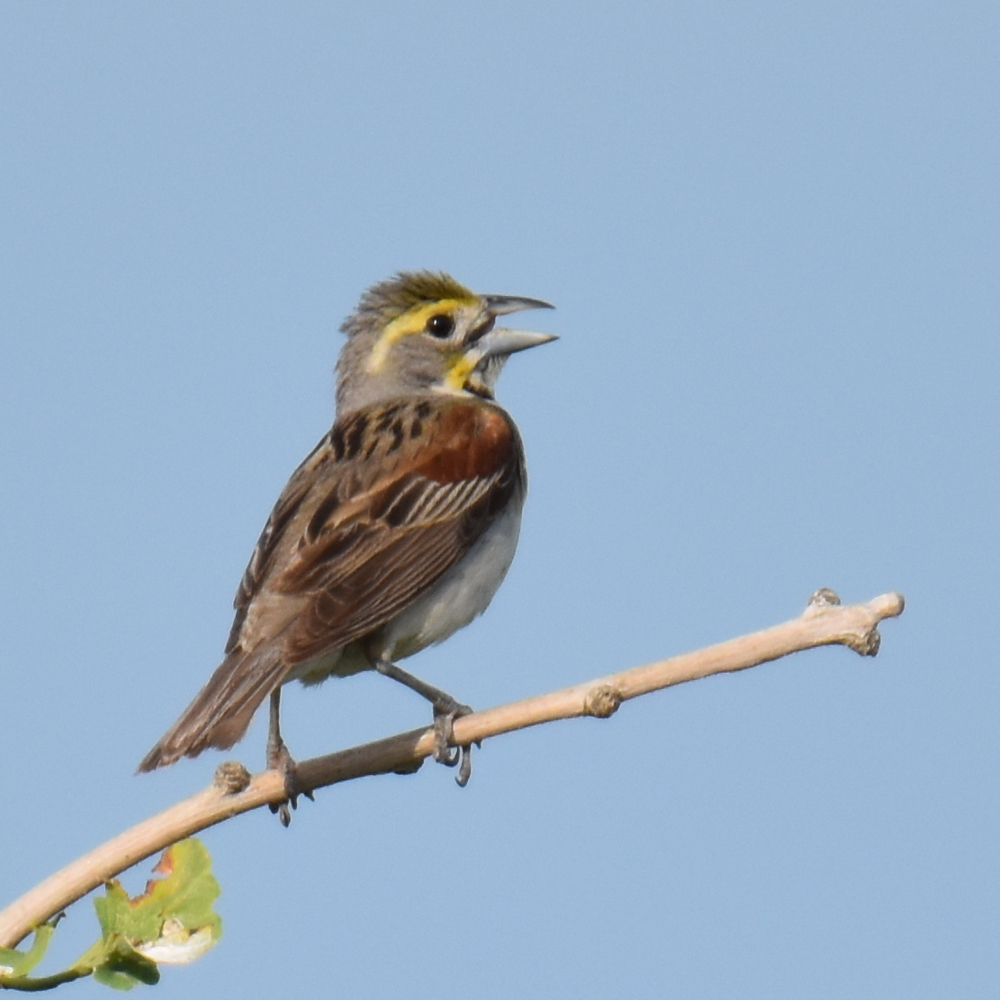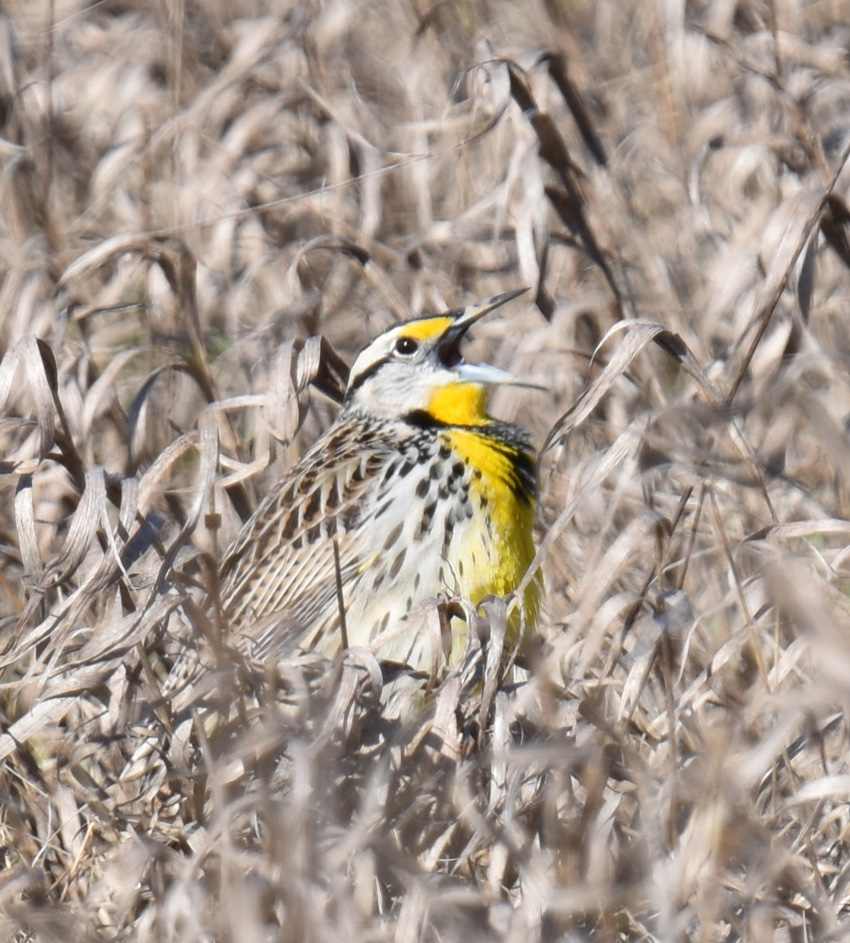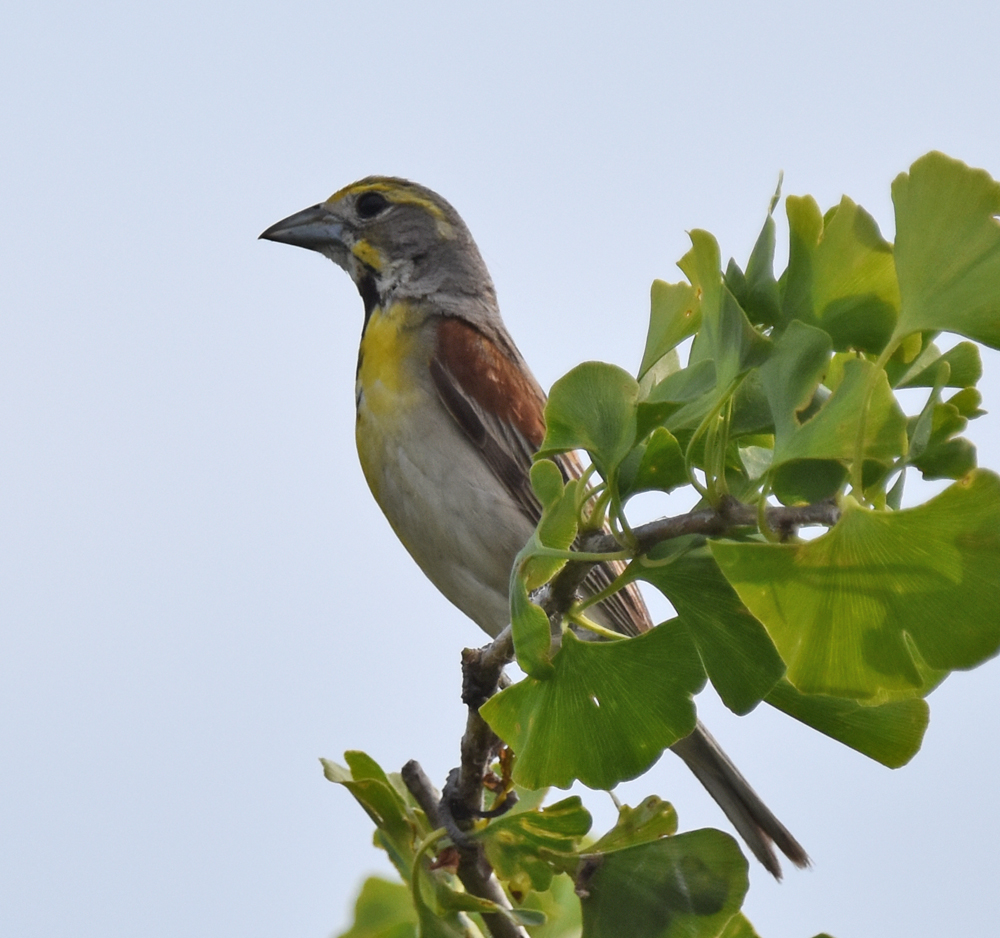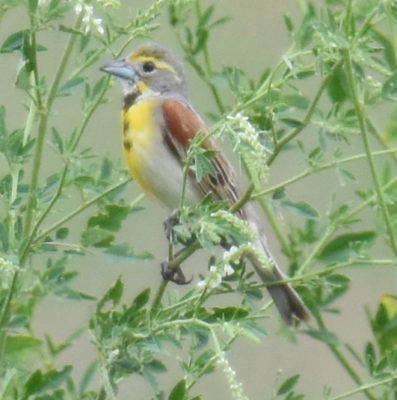I never knew the town of Milton had a Velodrome although I should have since it was used for bicycle events for the PanAm Games. When the invasion of the RichardCissels of 2017 began, I didn’t ever expect to see one: I don’t go far to look at birds. Then the reports started flooding in about several being seen at the Milton Velodrome—and I realized I would be chauffeuring one of my brood and friends to a camp rendezvous fairly close by in west Oakville. So one chilly morning, I sallied forth and went searching for a “sparrow” with a bright yellow bib and some other unusual colouring.
What Does a Dicksissel Look Like and Where Might I Find One?
I remembered my “Tree” Sparrow fiasco, where I went looking for one without knowing its size, its preferred habits and its favourite food. I had, laughably, thought the name “Tree” meant I should look for it in trees. So I went to a nearby park, and spent ages staring at trees with no luck. Of course, when I finally found my first ones, they were feeding happily on the ground and on goldenrod seeds in a meadow. Go figure.
This time, I did a bit more early research:
I found the males at the Velodrome were most often seen perching on top of weeds to sing. (This was gleaned from eBird photos and from Luc Fazio’s informative video.)
(The female or females are being rarely seen so I didn’t have any expectation of seeing one. And I never did.)
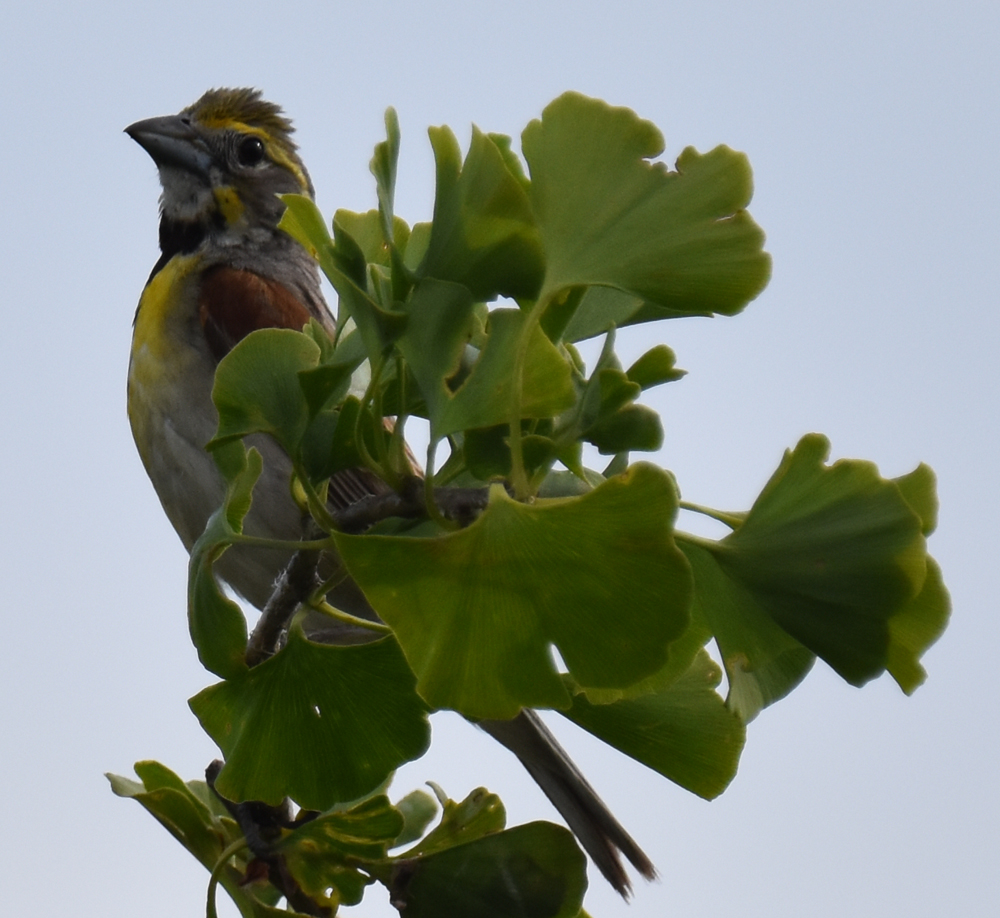
He struck a noble pose. And is this a Gingko sapling he’s perched in?
I also had some idea of the song from the video, and from the AllAboutBirds website where the song was similar but noticeably different. Knowing my habit of getting distracted by other birds’ songs (Savannah Sparrows and Song Sparrows are in the same field) I wrote myself the cheat sheet reminder: tweet, tweet, tweet, fzzzzzizzzziz. (You can see why Peterson’s has not hired me to write the catchy lyrical versions of bird songs for easy memorizing in their field guides….)
Of course, I forgot to check what size they are, though I knew their bill was supposed to be larger than a Savannah Sparrow’s.

Savannah Sparrows have a yellow eye line but no yellow on their front and no big patch of rufous on the wings. Their bills are also smaller than those of Dickcissels.
Luckily, I brought a field guide with me, and looked it up while I was in the parking lot: They are a bit smaller than a House Sparrow and should be noticeably larger than a Savannah Sparrow. They are about 75% of the size of a Meadowlark but to me they seem much smaller.
Are Dickcissels Sparrows?
Despite the fact I keep comparing them to sparrows, Dickcissels are not actually sparrows. Right now, they are listed in the same group as Cardinals, Grosbeaks, Indigo Buntings and Tanagers.
What Is This Miniature Meadowlark Singing from the White Sweet Clover in the Uncut Field?
Dickcissels remind me, and many other people, of Meadowlarks. That’s because the males have a yellow shirtfront with a small black “bowtie” similar to the yellow front and black V mark on a Meadowlark.
They both have some yellow near the eye, too, but a Meadowlark has a black eye line and a Dickcissel doesn’t. Meadowlarks also have streaky brown, black and white sides but Dickcissels don’t.
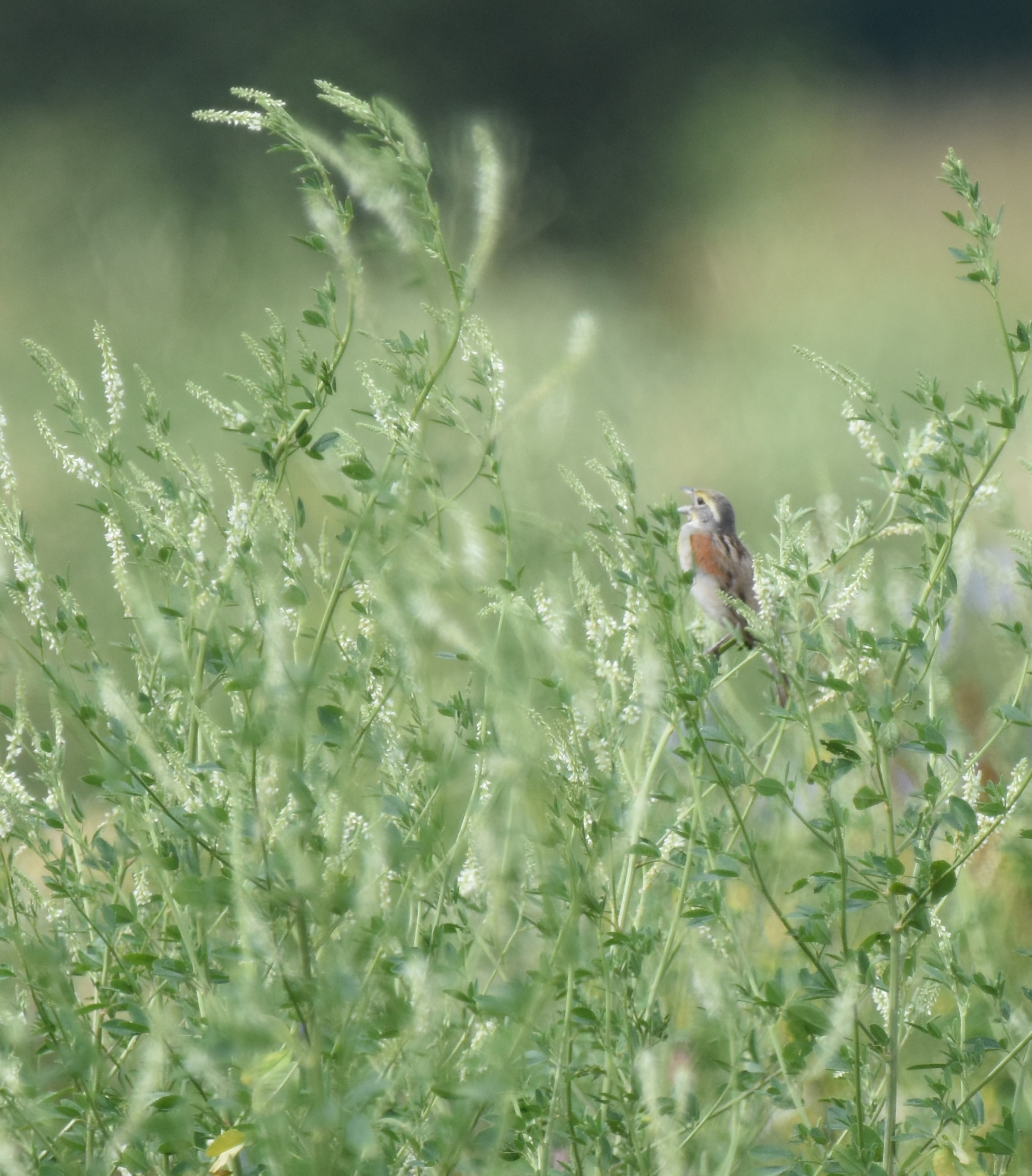
Seeing the rusty patch on this far away Dickcissel through my viewfinder was the first clue I had that I was focussing on the sought-after bird!
Dickcissel males do have a nice bright rusty patch on their sides, though. That helped me be sure I was seeing one while looking at a bird far away as the Sweet Clover it was one bobbed and swayed in the wind, hiding then revealing the bird perched on it.
Did I Find the Mysterious Invaders?
Yes! In fact, I saw one perched in a sapling beside the parking lot when I first arrived: but I didn’t know (for sure) what it was, and a car drove by and flushed it into the meadow almost immediately.
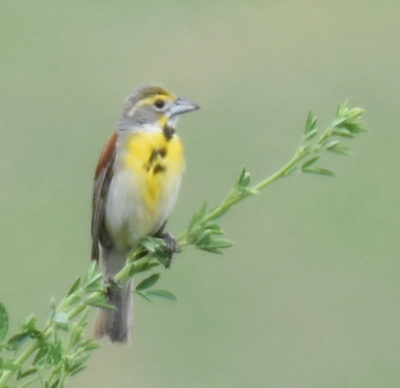
This somewhat fuzzy shot shows the front colouring. Often the black is one big triangle. I’m not sure if this is a younger male still growing in the full patch?
Then, after prowling around, I saw one for sure near the driveway entering the area. It was way back in the field but singing and visible. Its song was not the tweet, tweet, tweet, buzz I was listening for, of course, but it did have a buzz. And it was noticeably different than the more plentiful Savannah Sparrows.
Then I saw another one very clearly near where I had parked just before I had to leave.
So the next week, while back on chauffeur duty, I visited the Velodrome again. I decided just to stand near-ish to the saplings where I had seen the one singing the first time I visited.
Patience was a virtue. I was passed three times by someone walking laps around the cycle loop. I counted over 13 Clouded Sulphur butterflies and 3 Cabbage whites.
I could HEAR one singing but it remained stubbornly out of view behind a small berm.
Then it flew into the sapling near me! And I got great looks at it, even if I didn’t get great photos. (Holding a 600mm lens steady in the wind is not as easy as it might seem. That’s my excuse and I’m sticking with it.)
Are Dickcissels Common in Southern Ontario?
Not particularly. According to eBird articles, though, they have “irrupted” into southern Ontario in 2012 and 2005. The reason for irruptions don’t seem to be fully understood.
Why Are All These People With Binoculars and Big Cameras Standing Around the Mattamy National Cycling Centre in Milton?
When I first visited the Milton Velodrome area, I was asked by 3 people passing in cars what I was looking for or taking photos of. They had seen several people in the area over the past few days but I guess I looked more approachable, or was standing closer to the road on the cycling loop outside the building, and therefore could be contacted.
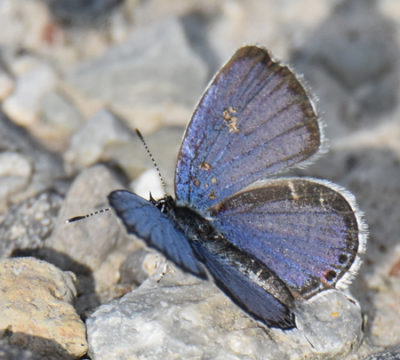
I enjoyed watching the butterflies like this Eastern-tailed Blue, too, while I was stalking Dickcissels.
I explained that there were several of an unusual sparrow-like bird around. The birds look like a sparrow with a bright yellow splash on its front. They only come up to Ontario every 5-10 years; they normally live further south in the US. The passersby were pleased to know what was going on and merrily drove on their way.
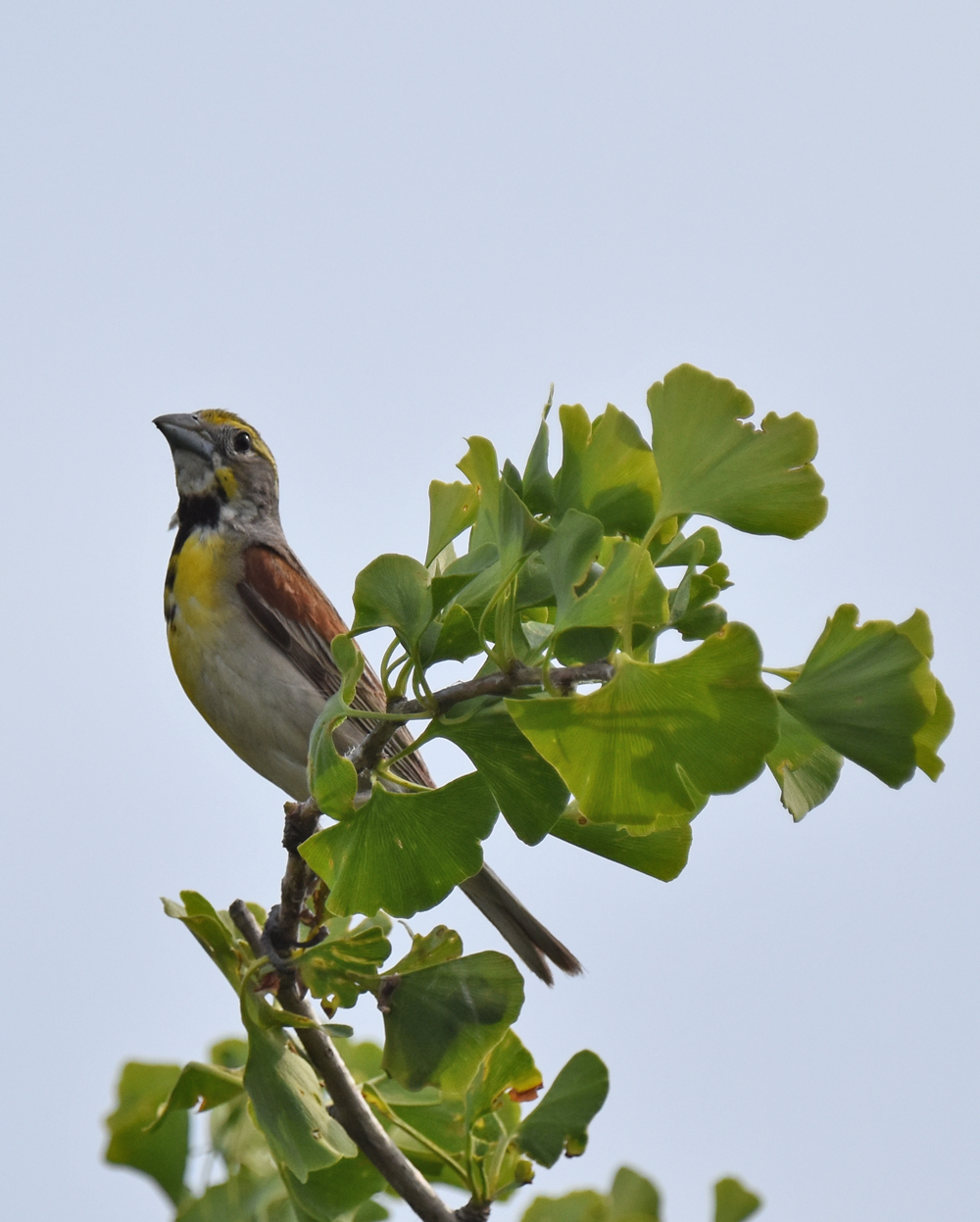 The Dickcissel spent his time always watching the overgrown field of Goldenrod, Asters, Chicory, Black-eyed Susans and White Sweet Clover. He never perched to look away from that area towards the parking lot or the Velodrome.
The Dickcissel spent his time always watching the overgrown field of Goldenrod, Asters, Chicory, Black-eyed Susans and White Sweet Clover. He never perched to look away from that area towards the parking lot or the Velodrome.
I wonder if any of them took a closer look later to find a Dickcissel for themselves? I hope so! They are attractive birds.
Related Reading
- The Song of a Spring Meadowlark
- [Savannah Sparrows Don’t Just Live in Georgia]
- What Black Bird has a Tan Helmet?
- Horned Larks on a Winter’s Day
- Dickcissels Push Northward (2012)
Join In
Did Dickcissels recently invade fields near you? Or are you one of the lucky southerners who has these bright birds every year? Please share your sighting with a comment.

